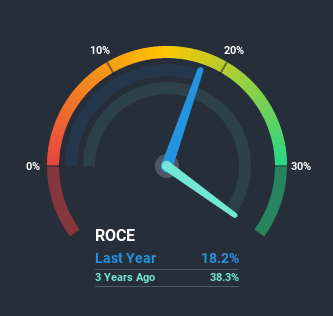- India
- /
- Construction
- /
- NSEI:INDIANHUME
Is Indian Hume Pipe (NSE:INDIANHUME) Likely To Turn Things Around?

If we want to find a potential multi-bagger, often there are underlying trends that can provide clues. One common approach is to try and find a company with returns on capital employed (ROCE) that are increasing, in conjunction with a growing amount of capital employed. Basically this means that a company has profitable initiatives that it can continue to reinvest in, which is a trait of a compounding machine. Having said that, from a first glance at Indian Hume Pipe (NSE:INDIANHUME) we aren't jumping out of our chairs at how returns are trending, but let's have a deeper look.
Return On Capital Employed (ROCE): What is it?
If you haven't worked with ROCE before, it measures the 'return' (pre-tax profit) a company generates from capital employed in its business. The formula for this calculation on Indian Hume Pipe is:
Return on Capital Employed = Earnings Before Interest and Tax (EBIT) ÷ (Total Assets - Current Liabilities)
0.18 = ₹1.2b ÷ (₹20b - ₹13b) (Based on the trailing twelve months to September 2020).
Thus, Indian Hume Pipe has an ROCE of 18%. On its own, that's a standard return, however it's much better than the 9.1% generated by the Construction industry.
Check out our latest analysis for Indian Hume Pipe

Historical performance is a great place to start when researching a stock so above you can see the gauge for Indian Hume Pipe's ROCE against it's prior returns. If you'd like to look at how Indian Hume Pipe has performed in the past in other metrics, you can view this free graph of past earnings, revenue and cash flow.
What Does the ROCE Trend For Indian Hume Pipe Tell Us?
On the surface, the trend of ROCE at Indian Hume Pipe doesn't inspire confidence. Around five years ago the returns on capital were 29%, but since then they've fallen to 18%. And considering revenue has dropped while employing more capital, we'd be cautious. This could mean that the business is losing its competitive advantage or market share, because while more money is being put into ventures, it's actually producing a lower return - "less bang for their buck" per se.
Another thing to note, Indian Hume Pipe has a high ratio of current liabilities to total assets of 65%. This can bring about some risks because the company is basically operating with a rather large reliance on its suppliers or other sorts of short-term creditors. While it's not necessarily a bad thing, it can be beneficial if this ratio is lower.The Bottom Line
From the above analysis, we find it rather worrisome that returns on capital and sales for Indian Hume Pipe have fallen, meanwhile the business is employing more capital than it was five years ago. And, the stock has remained flat over the last five years, so investors don't seem too impressed either. With underlying trends that aren't great in these areas, we'd consider looking elsewhere.
One more thing: We've identified 3 warning signs with Indian Hume Pipe (at least 1 which makes us a bit uncomfortable) , and understanding them would certainly be useful.
While Indian Hume Pipe may not currently earn the highest returns, we've compiled a list of companies that currently earn more than 25% return on equity. Check out this free list here.
If you decide to trade Indian Hume Pipe, use the lowest-cost* platform that is rated #1 Overall by Barron’s, Interactive Brokers. Trade stocks, options, futures, forex, bonds and funds on 135 markets, all from a single integrated account. Promoted
New: AI Stock Screener & Alerts
Our new AI Stock Screener scans the market every day to uncover opportunities.
• Dividend Powerhouses (3%+ Yield)
• Undervalued Small Caps with Insider Buying
• High growth Tech and AI Companies
Or build your own from over 50 metrics.
This article by Simply Wall St is general in nature. It does not constitute a recommendation to buy or sell any stock, and does not take account of your objectives, or your financial situation. We aim to bring you long-term focused analysis driven by fundamental data. Note that our analysis may not factor in the latest price-sensitive company announcements or qualitative material. Simply Wall St has no position in any stocks mentioned.
*Interactive Brokers Rated Lowest Cost Broker by StockBrokers.com Annual Online Review 2020
Have feedback on this article? Concerned about the content? Get in touch with us directly. Alternatively, email editorial-team (at) simplywallst.com.
About NSEI:INDIANHUME
Solid track record with adequate balance sheet and pays a dividend.


